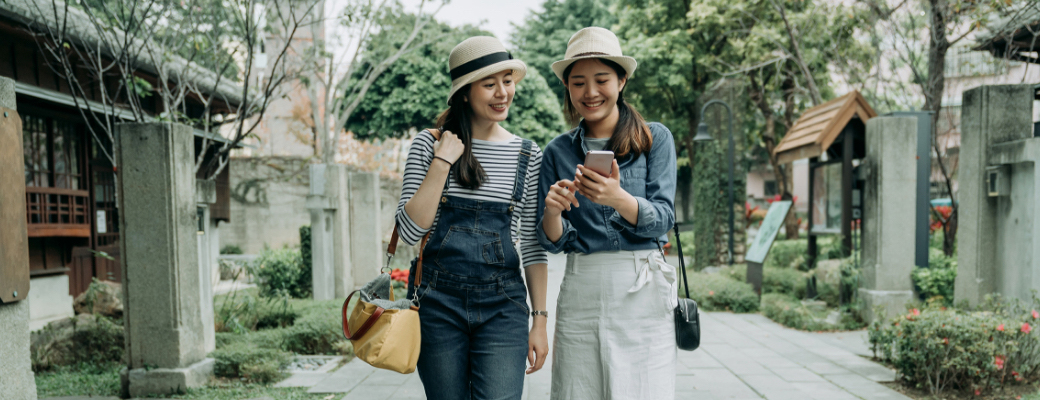
Food and Drinks
Take a relaxing break with cute sweets along the Nankai Line.

An introduction to shrine torii gates
Torii gate is that you see at the entrance when visiting a shrine. If you look closely, you will notice that the shape and color are different depending on the shrine. Why are torii gates built in the first place? In this article, we will explain in detail the origin and types of torii.
Torii are not only built as gates and symbols leading to shrines, but also represent the boundary between the sacred area inside the shrine (divine area) and the outside area where people live (the secular world). In addition to this, it is said that the torii also has the role of a "barrier" that prevents unclean things from entering the shrine.
Basically, each shrine has only one torii gate, but it is not uncommon for large shrines to have multiple torii gates.
There are several theories about the origin of torii, one is from the myth of the Kojiki. There is an episode that when Amaterasu Omikami hid herself in Amanoiwaya, other gods made a bird called "Tokoyonaganakidori" sing. It is a theory that originated from this "tree with a bird".
In addition to this, there is also a theory that it was introduced from overseas such as India and China.
Torii come in a variety of materials, shapes, and colors, but they can be broadly divided into two types: Shinmei torii and Myojin torii. If you further subdivide this by the difference in shrines and shapes,It is said that it can be divided into more than 60 types.
Shinmei torii gate
"Shinmei torii" is an overall straight torii, and both ends of the crossbar at the top of the torii are not warped. In addition, it features a simple shape in which both ends of the nuki below it do not protrude outside the pillar. It is often made of natural wood, and the torii at Ise Jingu Shrine is also this "Shinmei torii".
Myojin Torii Gate
“Myojin Torii” is characterized by the fact that both ends of the “Kasagi” curve upward toward the sky, and the “Shimagi” is layered underneath. The name of the shrine is written on the frame in the center. The vermillion torii gates are mainly categorized under this Myojin torii gate.
There is a theory that the reason why torii gates are red is that vermillion has long been believed to have the power to ward off evil in Japan. In addition, vermilion is associated with the color of blood flowing through the body, so it is said that it was also considered as a symbol of vitality. For this reason, it may have come to be used in shrines, which are sacred places, as a color that removes impurities and brings power.
However, not all torii are vermilion, and white and black torii also exist.
Finally, we will introduce the main shrines that you can visit along the Nankai line.
Sumiyoshi Taisha
The head office of approximately 2,300 Sumiyoshi shrines nationwide. Locals in Osaka call it “Sumiyossan” and it is a shrine that has been loved since ancient times. It is famous all over Japan, and more than 2.3 million people visit at the beginning of the year.
Hochigai-jinja
It is said that the shrine is located on the border of the three provinces of Settsu, Kawachi, and Izumi, so it is said to be "a clear place without direction." It is revered as a god of "hosai yoke" that protects the body from azimuth misfortune.
Imamiya Ebisu Shrine
A shrine dedicated to Ebisu, the god of prosperous business. Tokaebisu, held for three days from January 9th to 11th every year, is a very lively event, attracting about one million visitors every year.
Mozu Hachimangu
A historic shrine that is said to have been built during the reign of Emperor Kinmei during the Yamato period. The shrine is one of the largest in the prefecture. Here, you can draw a "Haniwa Mikuji" (ceremony fee1,000 yen) in a cute haniwa-like container. It is also famous for the Tsukimi Festival, which is held every year on the 15th day of the 8th month of the lunar calendar, during the mid-autumn harvest season.
Mt.Kongo Katsuragi Shrine
A shrine located near the summit of Mt. Kongo, which cuts across the prefectural border between Osaka and Nara. Currently, 38 Katsuragi shrines of the guardian deity of Mt. Kongo are enshrined together. Mt. Kongo has long been regarded as a sacred mountain that fuses and harmonizes the two beliefs of Shinto and Buddhism.
This time, I explained about the torii of the shrine. Torii has been familiar to Japanese people since ancient times, but you can see that there are various meanings and thoughts behind it. If you visit after knowing the meaning, it will surely be more meaningful.
How about visiting a shrine along the Nankai line on your next outing? There may be something new to discover.

